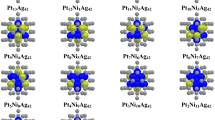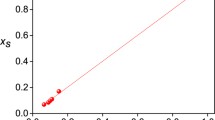Abstract
In this study, we have investigated structural and magnetic properties of the nanoalloys of size 38 atoms of compositions Ni32Co6-nRhn and 55 atoms of compositions Ni42Co13-nRhn. We have performed simulation searches for the lowest energy structures at Gupta level and then performed DFT re-optimization for these structures. The lowest energy structures of Ni32Co6-nRhn and Ni42Co13-nRhn nanoalloys at Gupta level were found to be truncated octahedron and icosahedron structure, respectively. The lowest energy values were found to be at the compositions Ni32Co4Rh2 in Ni32Co6-nRhn and Ni42Co1Rh12 in Ni42Co13-nRhn nanoalloys. Ni atoms full occupy only the surface of the truncated octahedron and icosahedron structure with the exception of bimetallic Ni42Rh13 nanoalloy. Since the energetic stability of the truncated octahedron and icosahedron can be rationalized in terms of local atomic pressure, we have calculated the local atomic pressures of the compositions. We have also investigated the size, geometric structure, and composition effects on magnetic properties as well as stability.











Similar content being viewed by others
Availability of data and materials
All data generated or analyzed during this study are included in this manuscript.
References
Ferrando R (2016) Structure and properties of nanoalloys. In: Palmer RE (ed) Frontiers of nanoscience. Elsevier
Akbarzadeh H, Mehrjouei E, Abbaspour M et al (2023) Thermal behavior of different types of Au–Pt–Pd nanoparticles: dumbbell-like, three-shell, core-shell, and random-alloy. Mater Chem Phys. https://doi.org/10.1016/j.matchemphys.2022.126955
Nelli D, Roncaglia C, Ahearn S et al (2021) Octahedral growth of ptpd nanocrystals. Catalysts. https://doi.org/10.3390/catal11060718
Johnston RL (2012) Metal nanoparticles and nanoalloys. In: Palmer RE (ed) Frontiers of nanoscience. Elsevier
Bell AT (2003) The impact of nanoscience on heterogeneous catalysis. Science (80- ). https://doi.org/10.1126/science.1083671
Di Paola C, Baletto F (2011) Oxygen adsorption on small PtNi nanoalloys. Phys Chem Chem Phys. https://doi.org/10.1039/c0cp01662d
Akbarzadeh H, Mehrjouei E, Abbaspour M, Shamkhali AN (2021) Melting behavior of bimetallic and trimetallic nanoparticles: a review of MD simulation studies. Top Curr Chem. https://doi.org/10.1007/s41061-021-00332-y
Toshima N, Ito R, Matsushita T, Shiraishi Y (2007) Trimetallic nanoparticles having a Au-core structure. Catal Today. https://doi.org/10.1016/j.cattod.2007.03.013
Tsai SH, Liu YH, Wu PL, Yeh CS (2003) Preparation of Au-Ag-Pd trimetallic nanoparticles and their application as catalysts. J Mater Chem. https://doi.org/10.1039/b300952a
Kushwah M, Bhadauria S, Arora K, Gaur MS (2019) Enhanced catalytic activity of chemically synthesized Au/Ag/Cu trimetallic nanoparticles. Mater Res Express. https://doi.org/10.1088/2053-1591/ab2b04
Sanders-Gutierrez OA, Luna-Valenzuela A, Posada-Borbón A et al (2022) Molecular dynamics and DFT study of 38-atom coinage metal clusters. Comput Mater Sci. https://doi.org/10.1016/j.commatsci.2021.110908
Cox AJ, Louderback JG, Bloomfield LA (1993) Experimental observation of magnetism in rhodium clusters. Phys Rev Lett. https://doi.org/10.1103/PhysRevLett.71.923
Cox AJ, Louderback JG, Apsel SE, Bloomfield LA (1994) Magnetism in 4d-transition metal clusters. Phys Rev B. https://doi.org/10.1103/PhysRevB.49.12295
Zitoun D, Respaud M, Respaud M et al (2002) Magnetic enhancement in nanoscale CoRh particles. Phys Rev Lett. https://doi.org/10.1103/PhysRevLett.89.037203
Muñoz-Navia M, Dorantes-Dávila J, Pastor GM (2004) Calculation of the orbital magnetic moments in fcc 3d–4d binary clusters: Co - Rh and Co - Pd. J Phys Condens Matter. https://doi.org/10.1088/0953-8984/16/22/026
Dennler S, Ricardo-Chavez JL, Morillo J, Pastor GM (2003) Density functional calculations on small bimetallic magnetic clusters. Eur Phys J D. https://doi.org/10.1140/epjd/e2003-00130-9
Sondón T, Saúl A, Guevara J (2007) Magnetic properties of Co-Rh and Ni-Rh nanowires. Phys B Condens Matter. https://doi.org/10.1016/j.physb.2007.04.089
Sondón T, Guevara J (2004) Magnetic properties of Ni-Rh clusters: behavior in the Ni-rich region. Phys B Condens Matter. https://doi.org/10.1016/j.physb.2004.09.101
Sondón T, Guevara J, Saúl A (2007) Study of the structure, segregation, and magnetic properties of Ni-Rh clusters. Phys Rev B - Condens Matter Mater Phys. https://doi.org/10.1103/PhysRevB.75.104426
Aguilera-Granja F, Longo RC, Gallego LJ, Vega A (2010) Structural and magnetic properties of X12 y (X, Y=Fe Co, Ni, Ru, Rh, Pd, and Pt) nanoalloys. J Chem Phys 10(1063/1):3427292
Kutyła D, Salcı A, Kwiecińska A et al (2020) Catalytic activity of electrodeposited ternary Co–Ni–Rh thin films for water splitting process. Int J Hydrogen Energy. https://doi.org/10.1016/j.ijhydene.2020.05.196
Settem M, Ferrando R, Giacomello A (2022) Tempering of Au nanoclusters: capturing the temperature-dependent competition among structural motifs. Nanoscale. https://doi.org/10.1039/d1nr05078h
Zhu B, Front A, Guesmi H et al (2017) Magic compositions in Pd-Au nanoalloys. Comput Theor Chem. https://doi.org/10.1016/j.comptc.2016.12.023
Chen F, Johnston RL (2008) Energetic, electronic, and thermal effects on structural properties of Ag - Au nanoalloys. ACS Nano. https://doi.org/10.1021/nn700226y
Garip AK, Arslan H, Rapetti D, Ferrando R (2020) A DFT study of chemical ordering and oxygen adsorption in AuPtPd ternary nanoalloys. Mater Today Commun. https://doi.org/10.1016/j.mtcomm.2020.101545
Wu GH, Liu QM, Wu X (2015) Geometrical and energetic properties in 38-atom trimetallic AuPdPt clusters. Chem Phys Lett. https://doi.org/10.1016/j.cplett.2014.12.022
Wu G, Sun Y, Wu X et al (2017) Large scale structural optimization of trimetallic Cu–Au–Pt clusters up to 147 atoms. Chem Phys Lett. https://doi.org/10.1016/j.cplett.2017.08.049
Taran S, Garip AK, Arslan H (2020) A theoretical study on chemical ordering of 38-atom trimetallic Pd-Ag-Pt nanoalloys. Chinese Phys B. https://doi.org/10.1088/1674-1056/ab99b4
Taran S, Garip AK, Arslan H (2020) Chemical ordering effect on structural stability of trimetallic Cu-Au-Pt nanoalloys. Phys Scr. https://doi.org/10.1088/1402-4896/aba3ab
Cyrot-Lackmann F, Ducastelle F (1971) Binding energies of transition-metal atoms adsorbed on a transition metal. Phys Rev B. https://doi.org/10.1103/PhysRevB.4.2406
Rosato V, Guillope M, Legrand B (1989) Thermodynamical and structural properties of f.c.c. transition metals using a simple tight-binding model. Philos Mag A. https://doi.org/10.1080/01418618908205062
Taran S, Arslan H (2020) Stability and magnetic behaviour of 19-, 23- and 26-atom trimetallic Pt–Ni–Ag nanoalloys. Mol Phys. https://doi.org/10.1080/00268976.2020.1818859
Taran S, Garip AK, Arslan H (2021) Investigation of the chemical ordering and structural properties of the trimetallic (PtNi)@Ag nanoalloys. J Clust Sci. https://doi.org/10.1007/s10876-020-01778-8
Cleri F, Rosato V (1993) Tight-binding potentials for transition metals and alloys. Phys Rev B. https://doi.org/10.1103/PhysRevB.48.22
Akbarzadeh H, Mehrjouei E, Ramezanzadeh S, Izanloo C (2017) Ni-Co bimetallic nanoparticles with core-shell, alloyed, and Janus structures explored by MD simulation. J Mol Liq. https://doi.org/10.1016/j.molliq.2017.10.135
Varas A, Aguilera-Granja F, Rogan J, Kiwi M (2015) Structural, electronic, and magnetic properties of FexCoyNiz (x + y + z = 13) clusters: a density-functional-theory study. J Magn Magn Mater. https://doi.org/10.1016/j.jmmm.2015.06.088
Fromen MC, Morillo J, Casanove MJ, Lecante P (2006) Structure and chemical order in Co-Rh nanoparticles. Europhys Lett. https://doi.org/10.1209/epl/i2005-10469-3
Yıldırım H, Göcen T, Garip AK (2022) Melting behavior of Ir-Ag-Au nanoalloys: a molecular dynamic study. Mol Simul. https://doi.org/10.1080/08927022.2022.2072839
Akbarzadeh H, Abbaspour M, Mehrjouei E (2018) Effect of systematic addition of the third component on the melting characteristics and structural evolution of binary alloy nanoclusters. J Mol Liq. https://doi.org/10.1016/j.molliq.2017.11.075
Perdew JP, Burke K, Ernzerhof M (1996) Generalized gradient approximation made simple. Phys Rev Lett. https://doi.org/10.1103/PhysRevLett.77.3865
Giannozzi P, Baroni S, Bonini N et al (2009) QUANTUM ESPRESSO: a modular and open-source software project for quantum simulations of materials. J Phys Condens Matter. https://doi.org/10.1088/0953-8984/21/39/395502
Giannozzi P, Andreussi O, Brumme T et al (2017) Advanced capabilities for materials modelling with Quantum ESPRESSO. J Phys Condens Matter. https://doi.org/10.1088/1361-648X/aa8f79
Vanderbilt D (1990) Soft self-consistent pseudopotentials in a generalized eigenvalue formalism. Phys Rev B 41:7892. https://doi.org/10.1103/PhysRevB.41.7892
Yıldırım H, Kanbur U, Arslan H (2022) Poly-icosahedral Co–Fe–Pd nanoalloy: isomerism effect on the structural and magnetic properties from DFT. Phys B Condens Matter. https://doi.org/10.1016/j.physb.2022.414122
Ferrando R (2015) Symmetry breaking and morphological instabilities in core-shell metallic nanoparticles. J Phys Condens Matter. https://doi.org/10.1088/0953-8984/27/1/013003
Ferrando R (2018) Stress-driven structural transitions in bimetallic nanoparticles. Front Nanosci. https://doi.org/10.1016/B978-0-08-102232-0.00006-3
Taran S, Yildirim H, Arslan H (2021) Structural and magnetic properties of polyicosahedral Ni-Pt-Cu ternary nanoalloys. J Phys B At Mol Opt Phys. https://doi.org/10.1088/1361-6455/ac0fcc
Acknowledgements
The DFT calculations reported in this paper were fully performed at TUBITAK ULAKBIM, High Performance and Grid Computing Center (TRUBA resources).
Author information
Authors and Affiliations
Contributions
Songül Taran: conceptualization, methodology, formal analysis, investigation, writing—original draft, writing—review and editing. Haydar Arslan: conceptualization, methodology, formal analysis, investigation, writing—original draft, writing—review and editing.
Corresponding author
Ethics declarations
Ethical approval
This declaration is not applicable.
Competing interests
The authors declare no competing interests.
Additional information
Publisher's Note
Springer Nature remains neutral with regard to jurisdictional claims in published maps and institutional affiliations.
Rights and permissions
Springer Nature or its licensor (e.g. a society or other partner) holds exclusive rights to this article under a publishing agreement with the author(s) or other rightsholder(s); author self-archiving of the accepted manuscript version of this article is solely governed by the terms of such publishing agreement and applicable law.
About this article
Cite this article
Taran, S., Arslan, H. Theoretical insights into the structural and magnetic properties of trimetallic Ni-Co–Rh nanoalloys. Struct Chem 35, 777–790 (2024). https://doi.org/10.1007/s11224-023-02229-6
Received:
Accepted:
Published:
Issue Date:
DOI: https://doi.org/10.1007/s11224-023-02229-6




